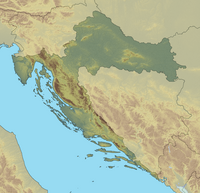Marjan, Croatia
| Marjan | |
|---|---|

Split harbor, the Riva, and Marjan in the background.
|
|
| Highest point | |
| Elevation | 178 m (584 ft) |
| Coordinates | 43°30′30″N 16°24′30″E / 43.50833°N 16.40833°ECoordinates: 43°30′30″N 16°24′30″E / 43.50833°N 16.40833°E |
| Geography | |
|
Location in Croatia
|
|
| Location | Marjan Park-Forest, Dalmatia, Croatia |
| Parent range | Dinaric Alps |
Marjan is a hill on the peninsula of the city of Split, largest city of Croatia's Dalmatia region. It is covered in a dense Mediterranean pine forest and completely surrounded by the city and the sea, making it a unique sight. Originally used as a park by the citizens as early as the 3rd century, it is a favorite weekend excursion destination and a recreational center for the city. It is also the setting for numerous beaches and jogging trails as well as tennis courts and the city Zoo, all surrounded by the scenic forest. The tip of the peninsula houses the Institute of Oceanography and Fisheries (Institut za oceanografiju i ribarstvo, IZOR).
Marjan is 178 m tall and offers a view of the entire city, the surrounding islands, and the nearby mountains of Mosor and Kozjak.
In ancient times Emperor Diocletian built his palace a few minutes walk from Marjan. This opulent palace-city was actually inhabited by up to 8,000 to 10,000 people, who required parks and recreation space, Diocletian therefore organized some areas of Marjan nearer to the palace as a park. There is also a small rustic early 13th century AD church situated on Marjan Hill. The church is dedicated to St. Nicholas (Sv. Nikole) a favourite saint of fishermen, of which there are many in Split. Two and a half kilometres further along the path that runs along the south rim of Marjan is the fifteenth century church of St. Jerome (Sv. Jeronima). The church has an altar carved by Andrija Aleši. Built into clefts in the cliffs directly above and behind St. Jerome are a group of Renaissance hermitage caves, first used in the 15th century. On the eastern slopes of the Marjan, just above the city, is Split’s old Jewish cemetery. First established in 1573, the cemetery has over 700 graves, with readable tombstones from the eighteenth to twentieth centuries, the last burial taking place in 1945 when it was closed and protected as a monument.
...
Wikipedia

